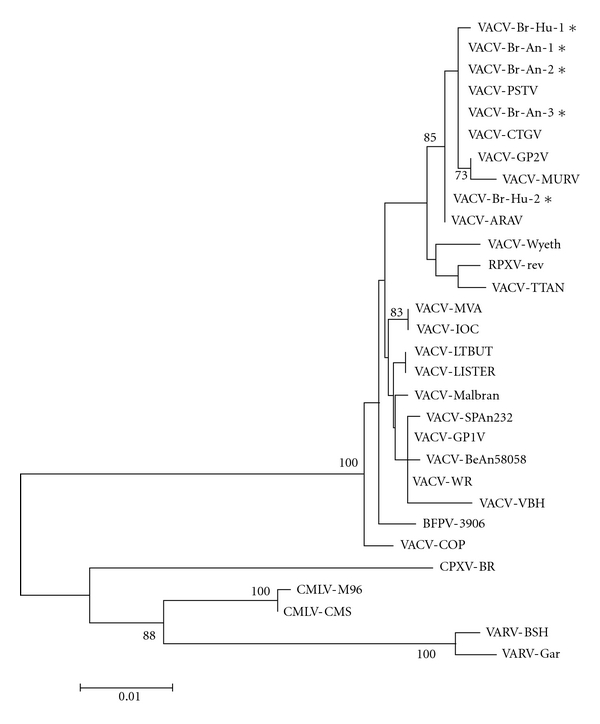Figure 1.

Phylogenetic relationships between the VACV samples obtained in this study and other relevant poxviruses. The phylogenetic tree was constructed by the Neighbor-joining method and used hemagglutinin gene nucleotide sequences from various orthopoxviruses, including Brazilian Vaccinia virus (VACV) isolates and other poxviruses. The Tamura3-parameter nucleotide substitution model was used and the reliability of the branching patterns was tested by 1000 bootstrap pseudo-replicates. Bootstrap values above 70% are shown. The scale bar represents 1% nucleotide sequence divergence. Samples are as follows: Zoonotic Brazilian Vaccinia virus isolated from humans (VACV-Br-Hu-1, VACV-Br-Hu-2) or cattle (VACV-Br-An-1, VACV-Br-An-2, VACV-Br-An-3)—labeled with stars (∗); other Vaccinia virus strains isolated in Brazil—Passatempo (VACV-PSTV), Cantagalo (VACV-CTGV), Araçatuba (VACV-ARAV), Guarani P2 (VACV-GP2V) (DQ206437), Muriaé (VACV-MURV), VACV-BeAn58058, Belo Horizonte (VACV-VBH), VACV-SPAn232, Guarani P1 (VACV-GP1V); reference Vaccinia virus strains—Western Reserve (VACV-WR), VACV-Lister, Modified virus Ankara (VACV-MVA), Copenhagen (VACV-COP), VACV-Wyeth, VACV-TTan, VACV-Malbran, Lister Butantan (VACV-LTBUT); VACV-IOC (AF229248), Buffalopox virus (BFPV-3906) (AF375077); other Orthopoxviruses—Cowpox virus Brighton Red (CPXV-BR), Rabbitpox virus rev (RBPV-rev), Ectromelia virus Moscow (ECTV), Camelpox virus CMS (CMLV-CMS), Camelpox virus M-96 (CMLV-M96), Variola virus Garcia-1966 (VARV-GAR), and Variola virus Bangladesh-1975 (VARV-BSH).
